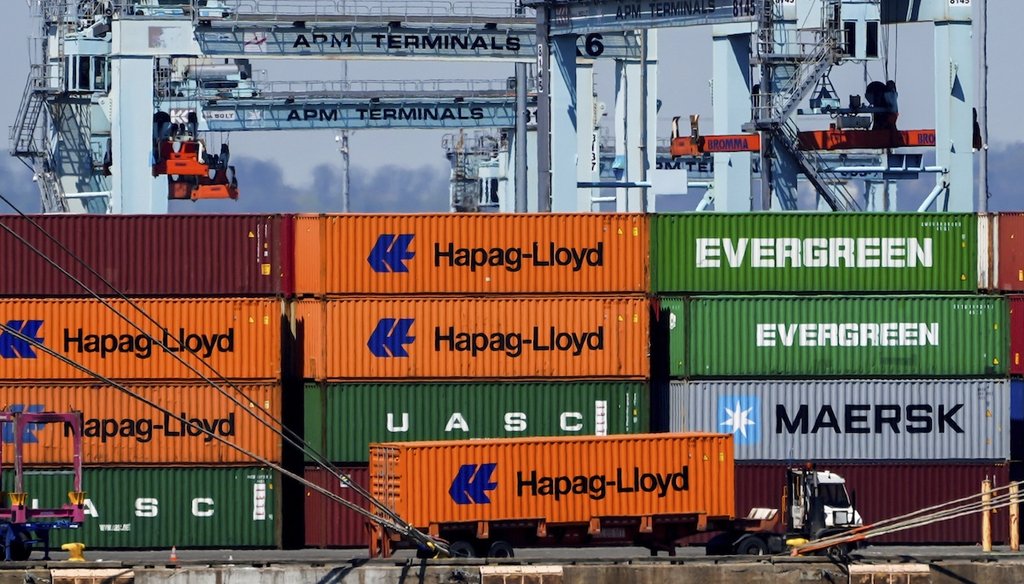Get PolitiFact in your inbox.
The now-paused tariffs Trump touted as reciprocal actually weren’t

A truck moves a shipping container at the Port Newark Container Terminal on April 18, 2025, in Newark, N.J. (AP)
At his "Liberation Day" tariffs event, President Donald Trump unveiled what he described as a reciprocal tariff plan affecting most countries.
A week later, Trump abruptly paused these tariffs for 90 days, although he kept in place an across-the-board 10% tariff and hiked Chinese tariffs up to 145%. By then, the stock market had plunged.
Regardless of Trump's moves and their market impact, the math underpinning his "reciprocal" plan made clear that they weren't reciprocal at all.
Tariff reciprocity had been Trump's longstanding trade policy aim. During the 2024 campaign, he said, "If they charge us, we charge them — an eye for an eye, a tariff for a tariff, same exact amount."
At the April 2 White House event, Trump used similar framing when releasing a list of new tariffs as high as 50% on virtually every country: "Reciprocal — that means they do it to us and we do it to them. Very simple — can't get any simpler than that."
However, the White House did not come up with its country-by-country tariffs by equalizing U.S. tariff rates with those imposed on the U.S. by other countries. Instead, it based the rate on the U.S. trade deficit with each country. Experts say this is not equivalent to reciprocity.
The White House's formula for calculating the April 2 tariff plan stemmed from some basic numerical inputs: It took the U.S. trade deficit in goods (but not services) with a particular country, divided it by the total value of goods imported into the U.S. from that country, then divided that by two.
As we reported, this formula produced higher tariff rates for countries which the U.S. receives more imports more than it sends exports.
The fact that the formula places high tariffs on these countries does not mean that these countries levy high tariffs on the U.S. According to Trump's list, many of the highest-tariffed countries were small in population, poor as measured by gross domestic product per capita, or both. Some of these countries have natural resources in high demand in the U.S., but are home to few people who can afford to buy U.S.-made products such as cars or computers.
For instance, Madagascar, an island nation off Africa's mainland that was among the nations with the highest proposed tariffs, "has roughly 80% of the global supply of vanilla," said Ross Burkhart, a Boise State University political scientist who studies trade policy. "The U.S. cannot produce vanilla, but needs it in foodstuffs, so purchases it. Madagascar is a relatively poor country, so it cannot make up in purchases what it makes in exported vanilla."
The top tariff rate on Trump's list was for Lesotho, a country landlocked by South Africa. Lesotho "exports diamonds and textiles and doesn't import many expensive capital- and technology-intensive U.S. goods," said Kent Jones, a Babson College emeritus economic professor. "Why should its bilateral trade with the U.S. be balanced?"
Countries like Madagascar and Lesotho do impose tariffs, but their tariff levels are not especially high compared to the rest of the world. The two nations' overall tariff rates for all countries, including the U.S., rank 53rd and 107th in the world, respectively.
In other words, while Trump said in the campaign these "reciprocal" tariffs would be for "the same exact amount" as the other country levied tariffs against the U.S., the now-paused country-by-country tariffs were not determined by reciprocity.
"A reciprocal tariff would take into account the other country's tariff rates on goods and services," Burkhart said. Simply put, he said, these tariffs "are not reciprocal tariffs."
If Trump wanted reciprocity, he "would accept zero-for-zero tariffs as a solution," but he has not done so, Jones said.
Our ruling
During the campaign, Trump promised, "If they charge us, we charge them — an eye for an eye, a tariff for a tariff, same exact amount."
Trump may have described the April 2 country-by-country tariffs as "reciprocal," but that doesn't mean that they were.
The tariff rates he prepared to impose didn't take into account whether that partner was imposing any kind of tariff on the U.S. Instead, the administration calculated the rates based on whether that country has a trade surplus with the U.S. — something that can happen for many reasons, including a nation's specialized exports of its natural resources, its poverty or its small size.
Trump has paused country-by-country tariffs for 90 days. If he reimposes them as he outlined April 2, he would not be enacting the reciprocal tariffs he campaigned on.
There is no movement on the original promise to charge tariffs of the "same exact amount" countries charge the U.S. That fits our definition of Stalled.
Our Sources
Donald Trump, remarks at the White House, April 2, 2025
White House, list of country-by-country tariffs, April 2, 2025
World Bank, "Tariff rate, applied, weighted mean, all products," accessed April 14, 2025
Axios, "How to read the White House's tariff formula," April 3, 2025
New York Times, "How Are Trump's Tariff Rates Calculated?" April 2, 2025
BBC, "How were Donald Trump's tariffs calculated?" April 3, 2025
Newsweek, "Donald Trump Rejects Europe's Offer to Drop Tariffs: 'They Are Screwing Us,'" April 8, 2025
PolitiFact, "Are other countries 'cheating' the U.S. on trade?" April 9, 2025
Email interview with Ross Burkhart, Boise State University political scientist, April 11, 2025
Email interview with Kent Jones, emeritus economic professor at Babson College, April 11, 2025
